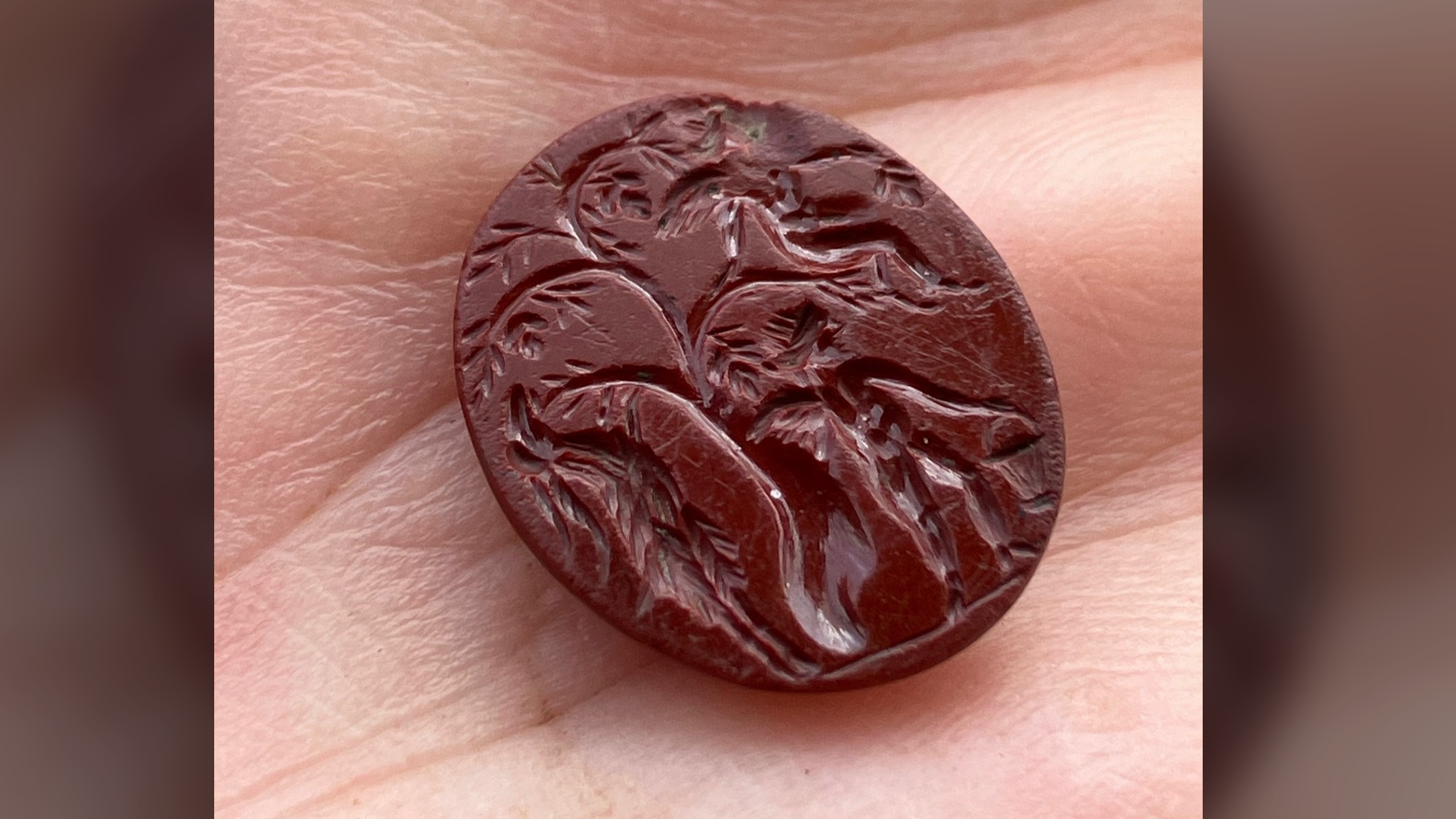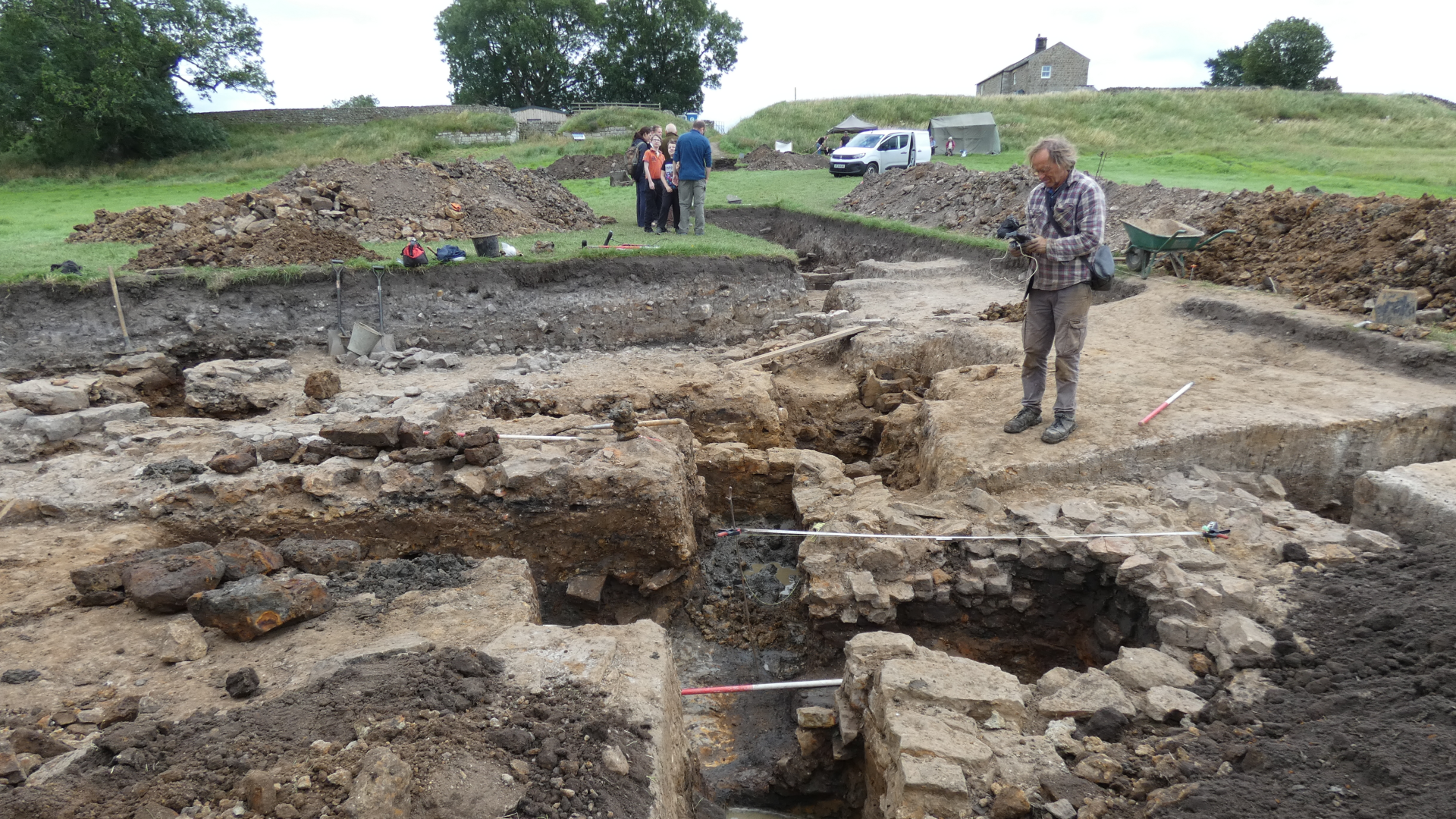Archaeologists find 'unique' blood-red gemstone at Roman fort beyond Hadrian's Wall
Archaeologists discovered the engraved gemstone at Bremenium, a fort north of Hadrian's Wall.

Excavations at a Roman fort in England north of Hadrian's Wall have revealed a unique engraved gemstone depicting a grape-harvesting scene from Roman mythology — imagery that's rarely found in northern Europe.
The red stone was likely originally set in a signet ring and used by a Roman man as his personal correspondence stamp, Bob Jackson of the Redesdale Archaeology Group, who has overseen multiple digs at the site, said in a statement. The design is "thought to be unique in Britain and northern Europe," excavation director Richard Carlton, an archaeologist at Newcastle University, said in the statement.
Researchers recently wrapped up the fifth season of excavation at Bremenium, a Roman fort in Northumberland, about 24 miles (39 kilometers) north of Hadrian's Wall. Originally constructed in the late first century A.D., Bremenium was important for military operations in Scotland and for warning the Romans about attacks from the north. After Hadrian's Wall was completed in A.D. 128, Bremenium became a key communications outpost.
Since 2021, archaeological excavation has focused on the structures outside the main fort, which were built and rebuilt several times between the late first and third centuries. Researchers also discovered a rare lime kiln in a previous excavation at Bremenium. It was likely used to produce quicklime — the basis for mortar, plaster and concrete — to construct the fort's ramparts, or defensive walls.
"The results in 2025 add to those made in previous years by confirming the presence of the inner enclosure wall," Carlton said. "Numerous pottery and other items indicate the original buildings were infilled, probably in the third century, with later buildings and yard surfaces."

Among the artifacts uncovered this year were examples of Roman pottery from across the Roman Empire, including an amphora, or clay jug, that was made in northern Spain to transport olive oil to Bremenium, according to the statement. The archaeologists also found a lead sling bullet from a Roman soldier's kit, a votive oil lamp, a lead seal for official documents, several brooches and two engraved gems called intaglios.
The larger intaglio depicts two winged Cupid figures picking grapes from a tree. There is a goat-like creature next to them, stretching itself up on its hind legs. The unusual intaglio is rare for northern Europe, according to Carlton, but it's similar to ones found in northern Italy and Croatia.
"It seems likely that the gem reflects the likely origin of the wearer, who may have come from the Mediterranean," Carlton told the BBC.
"This year's finds are exceptional in both quantity and quality," Jackson said. "The range of pottery and metalwork, especially the amphora and the intact brooches, offer new insights into trade, craftsmanship, and daily life at Bremenium."
The researchers plan to return to Bremenium next year for further excavations at the fort.
Editor's note: This story was updated at 12:15 p.m. ET on Nov. 7 to correct the word "northeastern" to "northern" in a quote.
Roman Britain quiz: What do you know about the Empire's conquest of the British Isles?

Kristina Killgrove is a staff writer at Live Science with a focus on archaeology and paleoanthropology news. Her articles have also appeared in venues such as Forbes, Smithsonian, and Mental Floss. Kristina holds a Ph.D. in biological anthropology and an M.A. in classical archaeology from the University of North Carolina, as well as a B.A. in Latin from the University of Virginia, and she was formerly a university professor and researcher. She has received awards from the Society for American Archaeology and the American Anthropological Association for her science writing.
You must confirm your public display name before commenting
Please logout and then login again, you will then be prompted to enter your display name.


